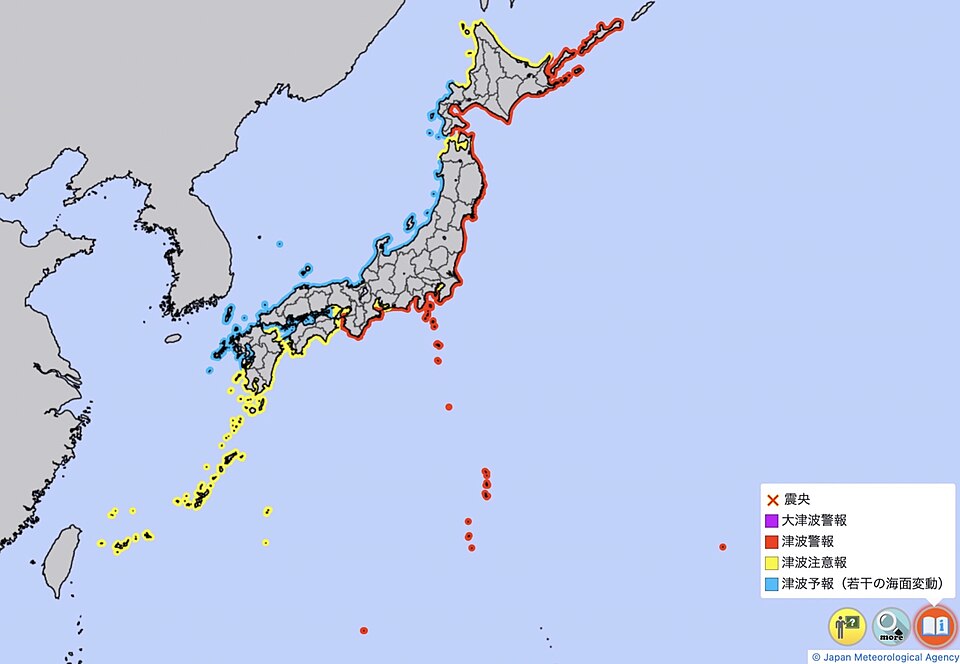Magnitude 8.8 Earthquake Off Russia Triggers Global Tsunami Alerts

A powerful earthquake measuring 8.8 on the Richter scale struck off the eastern coast of Russia near the Kamchatka Peninsula at approximately 11:25 local time on Wednesday, causing widespread tsunami warnings across the Pacific region. The earthquake, classified as one of the most severe in recorded history, has prompted urgent evacuations in multiple countries, including Japan and the United States.
According to the United States Geological Survey (USGS), this earthquake ranks as the sixth strongest since records began, matching the magnitude of the 2010 Biobío earthquake in Chile and the 1906 Esmeraldas earthquake in Ecuador. Dr. Helen Janiszewski, an Assistant Professor in the Geophysics and Tectonics Division at the University of Hawaii, noted, "Today’s earthquake is among the ten most severe in recorded history, which raises significant concerns regarding its aftereffects and potential for tsunami generation."
Initial reports indicate that tsunami waves measuring between 3 to 4 meters (10 to 13 feet) were observed in parts of Kamchatka, with the first waves of 30 cm (approximately 12 inches) already hitting the northern Japanese island of Hokkaido. Japanese authorities are monitoring the situation closely and have issued warnings regarding the potential for larger subsequent waves. Japan's Chief Cabinet Secretary, Yoshimasa Hayashi, stated that no casualties or significant damage have been reported thus far, but the situation remains fluid.
The US Tsunami Warning Center has issued alerts along the entire west coast of the United States, including Alaska and Hawaii. Hawaii's Department of Emergency Management has mandated immediate evacuations for parts of Oahu, urging residents to move to higher ground as destructive tsunami waves are anticipated. U.S. President Donald Trump expressed his concern via social media, urging citizens to stay informed through official channels.
In Kamchatka, regional officials reported injuries among residents during evacuation efforts, with some individuals requiring medical attention after jumping from windows. Fortunately, the region has not reported any fatalities thus far. Local emergency services continue to assess the damage, with reports of flooding in the port town of Severo-Kurilsk, which has a population of around 2,000.
The earthquake has reignited fears in Japan, where the Fukushima Daiichi nuclear plant, site of the catastrophic 2011 disaster, has been temporarily evacuated as a precaution. Tokyo Electric Power Company (TEPCO) stated that while no abnormalities have been detected at the plant, the situation is being closely monitored.
Historical context reveals that the Kamchatka Peninsula is a seismically active region, having experienced several significant earthquakes, including a 9.0 magnitude quake in 1952 that resulted in a devastating tsunami affecting Hawaii. The current earthquake's aftershocks are expected to continue, as warned by the Kamchatka branch of the Geophysical Service of the Russian Academy of Sciences, predicting magnitudes of up to 7.5 in the coming weeks.
Internationally, countries along the Pacific Rim are on high alert as tsunami waves could potentially reach as far as Ecuador, according to predictions from the US Tsunami Warning Center. As nations prepare for the possible fallout from this seismic event, the global community remains vigilant and responsive to both the immediate and long-term implications of this powerful earthquake.
Experts emphasize the importance of preparedness in the face of such natural disasters. Dr. Sarah Johnson, a seismologist with the National Earthquake Information Center, stressed, "We must continue to educate communities about earthquake readiness and tsunami awareness to mitigate potential risks and enhance safety protocols."
As the situation develops, authorities will continue to provide updates on evacuations, tsunami risks, and safety measures. The global response to this event underscores the interconnectedness of countries in mitigating the impacts of natural disasters, particularly in a region prone to seismic activity.
Advertisement
Tags
Advertisement




